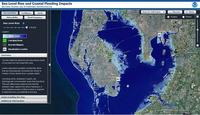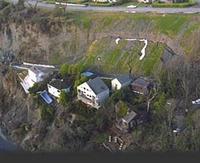-
Improving earthquake early warning systems
Earthquake early warning systems may provide the public with crucial seconds to prepare for severe shaking. For California, a new study suggests upgrading current technology and relocating some seismic stations would improve the warning time, particularly in areas poorly served by the existing network — south of San Francisco Bay Area to north Los Angeles and north of the San Francisco Bay Area.
-
-
Best way to stop a killer asteroid? Form a committee

The United Nations (UN) has adopted several recommendations of a new asteroid defense plan, the first steps in preventing Earth from being struck by an asteroid. The recommendations were a response to an asteroid strike earlier this year in Chelyabinsk, Russia. This object injured thousands and was around seventeen meters across. We have only found 1 percent of these “killer” asteroids, meaning there are hundreds of times more out there than we know of. One of them, sooner or later, will have our name written on it. For a global threat we need a global response, as well as a global share of the blame if it goes wrong.
-
-
Preventing a “cyber Pearl Harbor”
Cyber-security has become the new homeland security of the decade. Last year, then- Defense Secretary Leon Panetta issued a call to arms against cyberattacks, warning that sophisticated attacks against the United States could be America’s next “cyber Pearl Harbor.” It is imperative that we apply the same level of awareness and action as we have to the physical security of our facilities to ensure our security against this ever-evolving threat.
-
-
Melting Arctic sea ice increases summer rainfall in northwest Europe
A new study offers an explanation for the extraordinary run of wet summers experienced by Britain and northwest Europe between 2007 and 2012. The study found that loss of Arctic sea ice shifts the jet stream further south than normal resulting in increased rain during the summer in northwest Europe. The annual average extent of Arctic sea ice is currently declining at about half a million square kilometers per decade — equivalent to about twice the area of the United Kingdom.
-
-
NIST seeks public comments on updated smart-grid cybersecurity guidelines
The National Institute of Standards and Technology (NIST) is requesting public comments on the first revision to its guidelines for secure implementation of “smart grid” technology. The draft document, NIST Interagency Report (IR) 7628 Revision 1: Guidelines for Smart Grid Cybersecurity, is the first update to NISTIR 7628 since its initial publication in September 2010.
-
-
New method to help coastal communities adapt to sea-level rise

Future sea-level rise seems inevitable, although the rates and geographical patterns of change remain uncertain. Given the large and growing populations and economic activity in coastal zones, as well as the importance of coastal ecosystems, the potential impacts of sea-level change are far-reaching. Current methods to assess the potential impact of sea-level rise have varied significantly and hindered the development of useful scenarios and, in turn, suitable adaption policies and planning.
-
-
NIST releases Preliminary Cybersecurity Framework
The National Institute of Standards and Technology (NIST) on Tuesday released its Preliminary Cybersecurity Framework to help critical infrastructure owners and operators reduce cybersecurity risks in industries such as power generation, transportation, and telecommunications. In the coming days, NIST will open a 45-day public comment period on the Preliminary Framework and plans to release the official framework in February 2014.
-
-
$32 million NSF grants for improving prediction of, response to natural disasters
With Sandy’s one-year anniversary – 29 October – next week, how do scientists better predict and respond to natural hazards such as hurricanes, tornadoes, floods, earthquakes, tsunamis, and wildfires? To find answers, the National Science Foundation (NSF) recently awarded twelve new research grants totaling $32 million. The awards will advance understanding of natural hazards and of technological hazards linked with natural phenomena, as scientists study ways of predicting and responding to hurricanes, tornadoes, floods, earthquakes, tsunamis, wildfires.
-
-
Cyber Grand Challenge for automated network security-correcting systems
What if computers had a “check engine” light that could indicate new, novel security problems? What if computers could go one step further and heal security problems before they happen? To find out, the Defense Advanced Research Projects Agency (DARPA) intends to hold the Cyber Grand Challenge (CGC) — the first-ever tournament for fully automatic network defense systems. The Challenge will see teams creating automated systems that would compete against each other to evaluate software, test for vulnerabilities, generate security patches, and apply them to protected computers on a network. The winning team in the CGC finals would receive a cash prize of $2 million, with second place earning $1 million and third place taking home $750,000.
-
-
Quake-triggered landslides a significant hazard for Seattle

Seattle is prone to strong shaking as it sits atop the Seattle Basin — a deep sedimentary basin that amplifies ground motion and generates strong seismic waves that tend to increase the duration of the shaking. A new study suggests the next big quake on the Seattle fault may cause devastating damage from landslides, greater than previously thought and beyond the areas currently defined as prone to landslides.
-
-
The only effective asteroid defense: early detection – and evacuation of impact area

For the threat of meteor strikes large or small, early detection is key, and evacuation may be the only defense needed within the next 1,000 years, according to an asteroid impact expert. He says that the best investment in asteroid defense is not in weapons to deflect them, but in telescopes and surveys to find them.
-
-
Weatherizing U.S. homes to uniform standard to save $33 billion a year
The U.S. residential sector — 113 million homes — uses about 23 percent of total U.S. source energy annually (source energy includes site energy, the energy consumed by buildings for heating and electricity, as well as the raw energy required to transmit, deliver and produce it). A new study finds that upgrading buildings’ airtightness to a uniform level could achieve as much as $33 billion in annual energy savings.
-
-
Geologists: Sandy could happen again
Sandy’s storm surge hit the coast at high tide, but storm and tidal conditions were not the only cause of the devastation. Seawaters off New York’s coast have risen sixteen inches since 1778, the year of New York City’s first major recorded storm. Geologists say that due to rising sea levels, smaller storms could produce significant flooding.
-
-
New barrier system to protect Venice from rising seas

The City of Venice, Italy has carried out the first test of its $7.3 billion barrier system designed to protect the city from rising sea levels. The system, known as MOSE (MOdulo Sperimentale Elettromeccanico), consists of seventy-eight mobile barriers divided into four sections at the three inlets to the Venice lagoon.
-
-
Using hills to shelter buildings from tornadoes
Researchers have demonstrated the influence of hills on tornadoes. The researchers’ models revealed that the height of a hill and the size of a tornado’s vortex have a significant effect on the tornado’s destructive power. The findings could be used to identify safer areas for construction.
-
- All
- Regional
- Water
- Biometrics
- Borders/Immig
- Business
- Cybersecurity
- Detection
- Disasters
- Government
- Infrastructure
- International
- Public health
- Public Safety
- Communication interoperabillity
- Emergency services
- Emergency medical services
- Fire
- First response
- IEDs
- Law Enforcement
- Law Enforcement Technology
- Military technology
- Nonlethal weapons
- Nuclear weapons
- Personal protection equipment
- Police
- Notification /alert systems
- Situational awareness
- Weapons systems
- Sci-Tech
- Sector Reports
- Surveillance
- Transportation
Advertising & Marketing: advertise@newswirepubs.com
Editorial: editor@newswirepubs.com
General: info@newswirepubs.com
2010-2011 © News Wire Publications, LLC News Wire Publications, LLC
220 Old Country Road | Suite 200 | Mineola | New York | 11501
Permissions and Policies
Editorial: editor@newswirepubs.com
General: info@newswirepubs.com
2010-2011 © News Wire Publications, LLC News Wire Publications, LLC
220 Old Country Road | Suite 200 | Mineola | New York | 11501
Permissions and Policies
